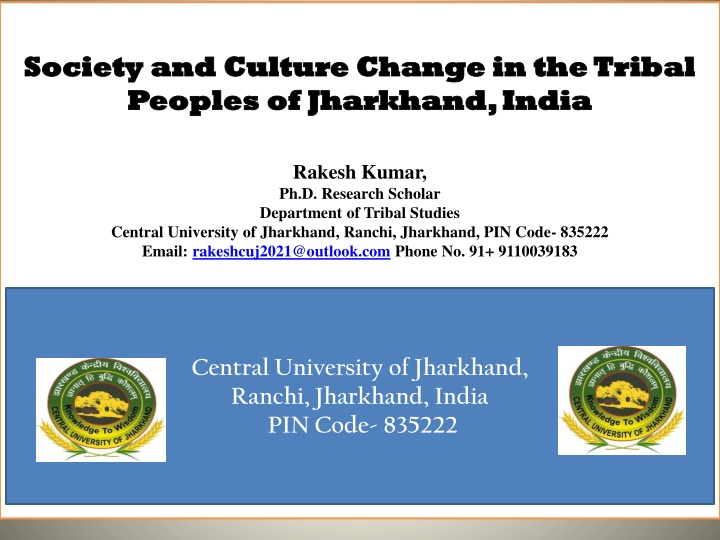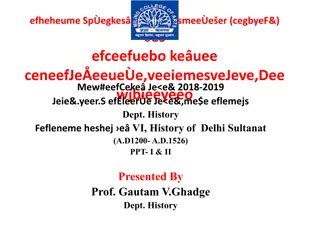
Culture Change Among Tribal Peoples of Jharkhand, India
Explore the societal and cultural transformations among the Tribal communities in Jharkhand, India, due to external influences and modernization, with a focus on historical, anthropological, and economic perspectives.
Download Presentation

Please find below an Image/Link to download the presentation.
The content on the website is provided AS IS for your information and personal use only. It may not be sold, licensed, or shared on other websites without obtaining consent from the author. If you encounter any issues during the download, it is possible that the publisher has removed the file from their server.
You are allowed to download the files provided on this website for personal or commercial use, subject to the condition that they are used lawfully. All files are the property of their respective owners.
The content on the website is provided AS IS for your information and personal use only. It may not be sold, licensed, or shared on other websites without obtaining consent from the author.
E N D
Presentation Transcript
Society Society and Culture Change in the Tribal and Culture Change in the Tribal Peoples of Jharkhand, India Peoples of Jharkhand, India Rakesh Kumar, Ph.D. Research Scholar Department of Tribal Studies Central University of Jharkhand, Ranchi, Jharkhand, PIN Code- 835222 Email: rakeshcuj2021@outlook.com Phone No. 91+ 9110039183 Central University of Jharkhand, Ranchi, Jharkhand, India PIN Code- 835222 \
Abstract The present study is based on secondary sources and qualitative methods along with historical and anthropological approaches for the study of society and culture changes among the Tribal peoples of Jharkhand. Man and society both have been the subjects of study of culture; and in the context of scientifically and systematically detailed study, culture itself is the way of living of man in the society. The patterns of culture in Tribal society is traditionally material culture which is based on co-operation and co-existence amid the nature where there traditional settlements or villages of Tribal peoples have been developed from the time immemorial.
Tribal peoples of this land have been lived in the forests, hills and their slops, valleys of hills and rugged areas near riverine or forests which could be easily recognized as their preferences to live isolated from the different culture of peoples. In the case of India and especially in Jharkhand, the society and culture of Tribal peoples of this land had been faced hazardously intrusion by the outsiders and intruders between mid of the 16th century and 20th century who imposed on them new rules and regulation along with the process of acculturation.
These whole processes started exploitation and conspiracy to snatch traditional tribal economic resources which were the main causes for making changes in the Tribal society and culture; and these processes of making changes in Tribal society and culture are continuingly still going on and on. In the present study, the researcher will focus in detailed on the above mentioned matters under the proposed title of this research paper. Keywords: Tribal, Society, Culture, Tribal Economy, Colonial, Outsiders, Jharkhand,
Introduction The word Tribe derived from the Latin word Tribus which signifies an inhabited place. A study by Mamata Choudhury, by citing and criticizing thoroughly the given definitions by many social scientists and scholars on Tribes of Ancient India found that it is challenging part of making a precise meaning of the term tribe , but it possess specific characteristics features such as, a group of peoples bearing a totemic name; prefer to live isolation; occupying a territory with certain tone of speaking language; possess common socio-religious rites and practices in their own traditional and customary norms, rules and regulations etc. (Chaudhury, 1977; Vidyarthi & Rai, 1976). Historically, Chota Nagpur, southern part of Bihar, is known as Jharkhand as the 28th state of India after carving out of Bihar on 15th November, 2000 which possesses undulating and rugged hilly areas, riverine and plain areas along with poor soil profile (Sinha, 1979, pp. 59-60).
As per the conserved archeological remains in provincial museum in Patna which had been found in different parts of Chota Nagpur Jharkhand proves its rich chalcolithic culture; and the Asur belongs to the chalcolithic men (Gautam, 2017, p. 1) who traditionally and technologically did metallurgy. There are found Negrito, Proto-Australoid, Mongoloid, Mediterranean and Nordic races in the population of tribal peoples of Jharkhand. The Proto-Australoid features are found in the Kharwar, Munda, Bhumij and Mal Paharias. The Dravidian tribes such as the Ho, Munda, Oraon, Kharia, Bhumij, Kisan, Santhal, Gond and Mal Paharia etc. are the major tribes of Jharkhand which are involved in the settled agriculture (Mohanty, 2006, p. 53; Sahay, 1992, p. 100; Chaudhury, 1977, p. 3). Tribal peoples of this land have been a long cultural and religious background history since time immemorial. In the course of time, they have to undergo a strenuous struggle for existence after adapting different modes of economic activities. Adapting nature of sustaining themselves in those ecological setting along with the undergoing processes of renovation in the old and traditional tools and equipment for making easy their games and economic activities, these all processes had made them able to develop a culture amid the nature.
Scientifically and historically, the culture, which has been developed by them, made them civilized. Joseph L. Scarpaci (2016) cited Glacken (1976) in his essay on material culture and the meaning of objects that Objects surrounding us in our everyday lives enhance our material, personal, and even spiritual welfare beyond their utilitarian function. The study of material culture is a useful venue to help us comprehend cultures and societies. (Scarpaci, 2016). Based on the above review it is the evidence that native peoples of this land Tribal habitually prefer to live isolation from the different culture of people to protect themselves in their traditional socio-economic, cultural and religious systems, but the processes of ongoing continuously changing of society and culture among them have been going on for a long time from pre-colonial to colonial period and also after independence.
Research Methodology After reviewing and analyzing the available literature on the present study, it is primarily based on the secondary data along with anthropological and historical methods and methodologies. Objective The relevance of the present study on Tribal peoples of Jharkhand, the researcher s objectives is very specific which are: 1. To study the culture and society of Tribal peoples of Jharkhand; and 2. To study the changes in Tribal culture and society.
Society and Culture L P Vidyarthi (1976) observed that social life is the essence of human life. It grows out of constant patterning of social interactions and relationships among human beings as such. (Vidyarthi & Rai, 1976, p. 145). As per the study by him, the social life in which human life survives by the help of material culture such as food, fuel, shelter, etc. is usually known as society. Tribal society is to be known as a group of peoples where tools and techniques, which could be recognized as material technology, had been developed by them as per their requirements since time immemorial. And furthermore, It is interesting to note that this material technology assisted them obtaining natural resources, erecting salters, making tools, preparing food, etc. which led them to establish hamlets, settlements or villages. Tribal society is intrinsically interlinked with social environment as social organizations, social interaction, social order on the base of community based ownership, co-operation and co-existence etc. which is recognized as Tribal culture (Vidyarthi & Rai, 1976).
Tribal Peoples of Jharkhand As per the Census of 2011, total population of Tribal peoples of India was 10,42,81,034, constituting 8.6 % of the total population of the country of which 0.83% (86,46,190) live in Jharkhand which is 26.21 % of total population (3,29,88,134) of it. As per the Draft National Tribal Policy, 2006 recorded 698 Tribal communities live in India, but the Census of India 2011 recorded them in the number of 705 in which 32 different Tribal communities live in Jharkhand (Report of the High Level Committee on Socio Economic, Health and Educational Status of Tribal Communities of India, 2014). Tribal community of Jharkhand came in contact with the British administration in the latter half of the 18th century when the Paharias of Rajmahal Hills revolted against the feudalism systems along with the British rules.
When the colonial rules started the merchandise capitalism based revenue systems in the form of Indian feudal systems, then a series of resistance, revolts and movements started against them one by another such as Dhalbhum rebellion (1776), Paharias rebellion (1778), Chuar rebellion among the Bhumij of Manbhum (1795-1800), Kol rebellion among the Ho of Singhbhum (1832), Bhumij revolt (1832-33), Santal rebellion (1855-56), Sardari Larai (1885) and Birsa Movement (1895-1900) etc. (Das, 1987) (Das, 1987; , 2017). In this way, based on the above study along past and present scenarios of Jharkhand movement on demanding a separate state from Bihar based on ethnic identity; and observations on ongoing Naxalbari Movement, Maoism Movement and Pathalgadi Movement (2017-2018) among the Tribal peoples of Jharkhand, it can be said in the that series of exploitation and absorption have been going in the scheduled areas since colonial time which have made the effects forces on making society and culture change in the Tribal Peoples of Jharkhand.
Social Change Cultural contact with the outsiders and intruders among the Tribal peoples during pre-colonial, colonial and also after independence have been the common factors of making continuingly efforts to alter in changing the society and culture among the Tribal peoples of Jharkhand. A study by N C Choudhury (1992) on Technology, Economic Constraints and Social Change among the Tribes of West Bengal found that the processes of acculturation into Christianity and Hinduization among them may be hardly recognized as social change, but seasonal migration of Tribal labourers in the industrial and agricultural sector in the metropolitan cities and villages of different states due to scarcity and poverty are the hallmark of changing society and culture among the Tribal peoples (Choudhury, 1992) A study by K N Sahay (1992) on Technology and Social Network: A Case- Study of some Changing Tribals of Chotanagpur found that advancement of technology along with the cultural contact with outsiders among the Tribal culture brought a continuous changes in each and every sphere among the Tribal society and culture (Sahay, 1992).
Conclusion Based on the above researches and reviews, the result reveals that, in the context of changing patterns of some perceptions e.g. undergoing in the contact with the outsiders from pre- colonial time to present situation, adopting modernity and development, different development programs by governments and non-government which are constantly going on in those scheduled areas where they inhabit since time immemorial have been primary causes in making changes among the Tribal society and culture. Along with these processes, some other causes have also been main factors for making changes among them e.g. deforestation, established industrial and mining sectors in those areas where they have been living since time immemorial.
Reference 1. (2014). Report of the High Level Committee on Socio Economic, Health and Educational Status of Tribal Communities of India. Government of India, Ministry of Tribal Affairs, . 2. Chaudhury, M. (1977). Tribes of Ancient India (Reprint 2000 ed.). Calcutta: Indian Museum. 3. Choudhury, N. C. (1992). Technology, Economic Constraints and Social Change among the Tribes of West Bengal. Indian Museum Bulletin, XXVII, 57-65. 4. Das, A. K. (1987). Scheduled Tribe and Scheduled Castes- A socio- Economic and Cultural Profile. Bulletin of the Cultural Research Institute, XVII(1 & 2), 1-8. 5. Gautam, A. (2017). Chota Nagpur- An Untold Histoy : A socio- Historical Analysis. Anthropol, 5(2), 1- 18. 6. Mohanty, P. K. (2006). Encyclopedia of Scheduled Tribes in India (Vol. 4). Delhi: Isha Books. 7. Sahay, K. N. (1992). Technology and Social Network: A Case-Study of some Changing Tribals of Chotanagpur. Indian Museum Bulletin, XXVII, 99-113. 8. Scarpaci, J. L. (2016). Material Culture and the Meaning of Objects. Material Culture, 48(1), 1-9. 9. Sinha, S. P. (1979). Baffling Problems of Sch. Tribes of Bihar. Bulletin of The Bihar Tribal Welfare Research Institute, XXI (1-2), 59-78. 10. Vidyarthi, L. P., & Rai, B. K. (1976). The Tribal Culture of India. New Delhi: Concept Publishing Company. 11. , . . (2017). : (7 ed.). : .
Thank Thank you very much you very much for listening me for listening me The End The End













